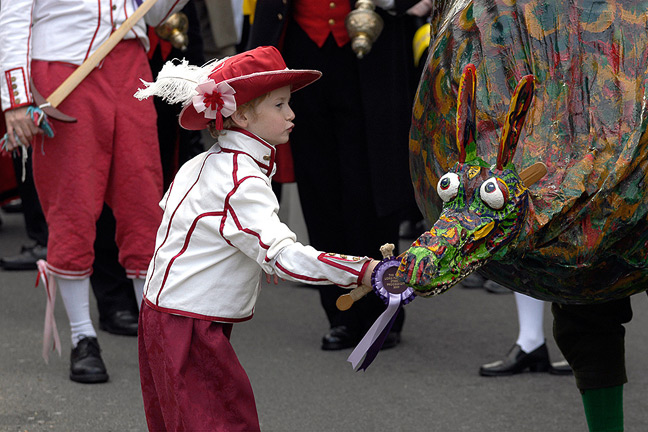Norwich Dragons
Here Be Dragons!
Why these big beasts feature in the Norwich Lord Mayor’s Street Procession, old and new

Whiffler child taunts Snap, Lord Mayor's Street Procession 2005. Catalogue entry: CAP/NNF/3/4/4/15
For hundreds of years – at least since 1408 - Norwich, once England’s second city, has maintained a tradition of street procession featuring the famous Snap dragon.
Once religiously inclined, the street procession showed St George, patron of England and of Norwich and its influential St George’s Guild, in conflict with a dragon, albeit one technically a hobbyhorse! St George represented the church, the dragon various kinds of wickedness and, probably, paganism.
In the three days up to Ascension Day, clerics processed around Norwich blessing the city and warding off Evil. The devil Snap dragon flapped its wings, and snapped its jaws, blowing out smoke and sparks to scare and delight the people of Norwich. Its reward: to be stoned and beaten and refused admittance to the cathedral where the climactic mass of the festival was held.
Yet so popular and iconic was Snap that come the Reformation – and after the banning of St George and Lady Margaret, the lady the dragon defended in one version of the ancient tale - Snap was allowed ‘for pastime … to come and show himself as in other years.’
In 1645, another setback interrupted our dragon’s progress: the Puritan government ordered that at the next procession there must be ‘no beating of drums or sounds of trumpets, no Snap-Dragon or fellows dressed up in Fools Coats and Caps; no standard with the George thereon, nor no hanging of Tapestry Cloth and Pictures in any of the streets’. However, in 1660, the monarchy was restored and all the old ways returned – including Snap. The dragon’s appearances continued and, in time, Norwich became quite famous for the scale and spectacle of its processions.
After 1731, when the Company of St George was finally wound up, Pagan Snap became Civic Snap: the property of the local authority and appeared on Guild Day when the Lord Mayor was inaugurated. This continued until 1835 when civic pageantry was swept away by national legislation. But Snap was not forgotten: in 1843 the Edinburgh Review claimed that Snap was ‘as necessary to the Mayor as his gold chain’ and sorely missed. Yet only occasional appearances are reported up to 1850.
However, a new and defiant tradition had emerged: the people of Pockthorpe, a part of Norwich outside its walls and over the water, had created their own dragon and their own mocking, subversive imitation of the Lord Mayor’s street procession. So the tradition of faux Snap terrorizing the people of Norwich continued: this dragon caused much hilarity by grabbing people’s hats or caps between its jaws and returning them only after a penny ransom had been paid. Young boys would taunt the dragon by running close by and chanting 'Snap, Snap, steal a boy's cap, give him a penny and he'll give it back'. These annual revelries continued until early in the twentieth century, according to oral history, right up to the First World War.
Snap’s name lived on in the 1930s in the form of a magazine, ‘Snapdragon’, to raise money in aid of hospitals. The Festival of Britain in 1951 saw the Pockthorpe dragon come to life again for a procession of ‘Norwich Through the Ages’. Around this time another very dilapidated dragon was found in the Backs Bar in Norwich.
Publicity led to curiosity so that the dragons found themselves conserved and on proud display in Norwich Castle. At this time, three Snaps and a head are to be found there. The publication of an important book about ‘Snap The Norwich Dragon’ by Richard Lane in 1976 led to his reappearance in the Lord Mayor’s Procession in the early 1980s and since that time the dragon has become well loved again, very visible in the culture of the city – and joined by newcomers.
One of the most notable modern dragons – Klang– suitably made in 2000 from reclaimed items: cheese graters, old cds et cetera, is more politically active than some of its predecessors, and better travelled too, visiting other festivals throughout Britain. More evidence of the enthusiasm for dragon making in Norfolk can be found on the website at: http://www.nor-folk.co.uk/Norwich%20Dragon

Klang dragon preparing to join the DragonFest in Norwich Cathedral grounds 2009.Catalogue entry: CAP/NNF/16/1/1
Perhaps Norwich needs Snap to represent the people of this radical city’s support for misrule, opposition and the irreverence. Thus Norwich as a city of revolt – Gladman’s Revolt and Kett’s Rebellion; thus its welcoming of ‘strangers’ – Dutch and Flemish immigrants ; thus its support for social reform – Elizabeth Fry and the abolitionists: and the Gurneys the Quaker banking dynasty; thus its radical character and the city’s contrarian stance to the Tory shire; these and Snap’s energy assert the spirit of Norwich – one of our finest cities in the twentieth and twenty first centuries.

Snap dragon at the Lord Mayor's Street Procession.Catalogue entry: CAP/NNF/3/4/4/14
Article by Norwich volunteer Chris Ball.





